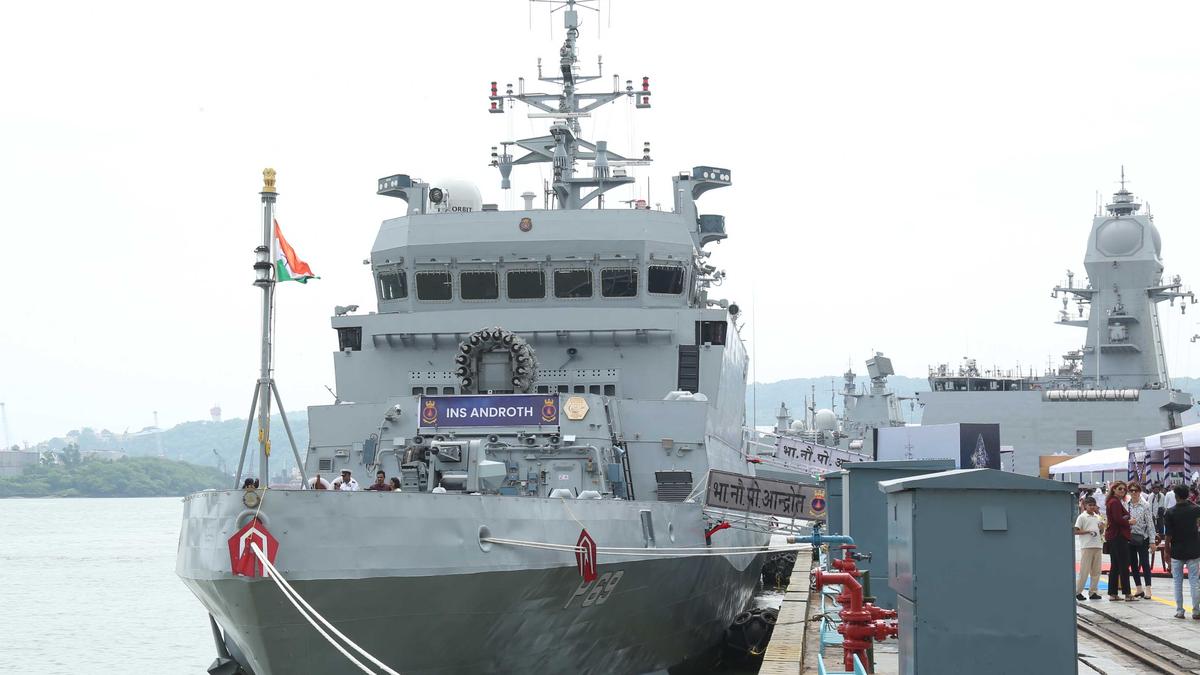Context:
Recently, the Indian Navy commissioned INS Androth, its second Anti-Submarine Warfare Shallow Water Craft (ASW-SWC), at the Naval Dockyard in Visakhapatnam.
About INS Androth:
INS Androth is the second ship of the Arnala-class Anti-Submarine Warfare Shallow Water Craft (ASW-SWC), built by Garden Reach Shipbuilders and Engineers (GRSE). INS Androth is designed specifically to detect, track, and neutralize underwater threats in coastal and shallow waters. It plays a crucial role in anti-submarine operations, maritime surveillance, search and rescue missions, and coastal defense.
Key Features Include:
-
- Class & Purpose: Part of the modern Arnala-class, replacing older Abhay-class corvettes to boost India’s coastal ASW capabilities.
- Dimensions: Length of 77.6 meters and displacement of 900 tonnes, enabling agility and maneuverability.
- Speed & Propulsion: Powered by a water-jet propulsion system linked to three marine diesel engines, it can reach speeds up to 25 knots—ideal for quick response in shallow waters.
- Indigenous Content: Reflecting India’s “Aatmanirbhar Bharat” vision, the ship is built with over 80% indigenous components.
- Armament: Equipped with indigenous lightweight torpedoes, anti-submarine rockets, naval mines, a 30mm surface gun, and remote-controlled 12.7mm guns.
- Sensors: Features the Abhay hull-mounted sonar, developed by DRDO and BEL, along with a low-frequency variable-depth sonar, enhancing underwater detection capabilities.
- Class & Purpose: Part of the modern Arnala-class, replacing older Abhay-class corvettes to boost India’s coastal ASW capabilities.
Strategic Significance of INS Androth:
1. Augmenting Littoral ASW Capability
Submarines represent a potent asymmetric threat in the Indian Ocean Region (IOR), particularly in shallow coastal zones. INS Androth strengthens India’s ability to detect, track, and neutralise these threats close to its shores, filling operational gaps left by older ships.
2. Coastal Defense & Maritime Domain Awareness
With evolving maritime challenges—unauthorised incursions, threats to offshore assets, sea lane security—vessels like Androth help maintain persistent presence in coastal waters. Their agility and sensor systems allow better surveillance, early warning, and patrol tasks which are critical for coastal security.
3. Indigenous Defence Manufacturing & Self‑Reliance
The high indigenous content in Androth’s construction is a sign of growing maturity in India’s shipbuilding and defence systems. This reduces dependency on foreign suppliers, shortens supply chains, boosts local industrial capability, and strengthens strategic autonomy in defence procurement and technology.
Conclusion:
The induction of INS Androth into the Indian Navy's fleet exemplifies India's growing self-reliance in defense manufacturing and its commitment to safeguarding national maritime interests. As part of the broader ASW-SWC series, INS Androth enhances the Navy's ability to counter underwater threats in littoral waters, contributing to regional maritime security.







